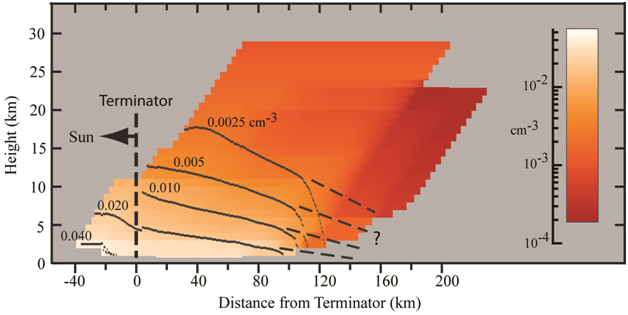Dynamic Response of the Environment At the Moon
Apollo-era measurements yield a 2D map of the lunar dust exosphere Jan 28, 2011
DREAM members Dave Glenar, Tim Stubbs and Rich Vondrak, along with collaborator J. McCoy, reanalyzed measurements of excess light found in Apollo 15 coronal photographs taken near orbital sunset (surface sunrise), and attributed to forward scattering of sunlight by lunar exospheric dust grains. The results, reported by Glenar's team, are currently in press to Planetary and Space Sciences.
Using the known sightline geometries together with a light scattering code, the measurements were used to construct a 2D "image" of dust concentration versus altitude and distance from the terminator (see figure). The dust exosphere was found to extend into shadow a distance somewhere between 100 and 200 km, depending on the uncertain contribution of coronal-zodiacal-light to the total brightness. Similar analyses of Apollo 15 and 17 photographs near orbital sunrise (surface sunset) revealed no such obvious excess light contribution. This suggests the possibility of a dawn-dusk asymmetry in exospheric dust related to the Moon's orbital motion, or else episodic changes in dust production from meteoroid streams. This picture of the dust distribution above the lunar terminator at one epoch should place new constraints on exospheric dust transport models, and help define observations planned for the Lunar Atmosphere and Dust Environment Explorer (LADEE).

Exospheric dust concentration versus height and distance from the terminator near surface sunrise, reconstructed from Apollo 15 orbital limb photographs. Numerical values correspond to grains of 0.10 micron radius, but relative concentration, and thus the shape of the dust exosphere, was found to be insensitive to grain size.

